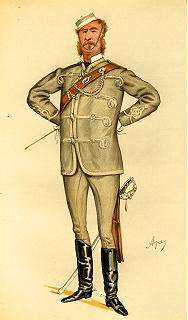Robert William Edis

Colonel Sir Robert William Edis KBE CB (13 June 1839 – 23 June 1927) was a British architect.[1] [2]
Born in Huntingdon, Edis was educated at Huntingdon Grammar School and Aldenham School before being articled to William Gilbee Habershon and Edward Habershon, architects, in London.[2] [1] He became chief assistant to Anthony Salvin, and joined the Architectural Association in 1859.[1] He was admitted an Associate of the Royal Institute of British Architects in 1862 and a fellow of the association in 1867.[1]
Although his early work was Gothic, Edis later became a proponent of the Queen Anne Style of baroque revival architecture. He worked mostly on private houses and public buildings, although he did design a few churches.[3]
He later became involved in the Aesthetic Movement of decorative arts and in furniture design, and delivered a series of Cantor lectures on the subject at the Royal Society of Arts. These formed the basis of two books: Decoration and Furniture of Town Houses (1881) and Healthy Furniture and Decoration (1884).[1] [4]
Edis had a long association with the Volunteer Force and its successor the Territorial Force. In 1868 he received a commission in the Artists Rifles.[5] He went on to be the regiment's commanding officer in 1883, and held the office of honorary colonel from 1909 until his death.[6] [7] [2] In January 1889 he was elected a member of the first London County Council, representing St Pancras South for three years as a member of the Conservative-backed Moderate Party.[8]
Edis had homes at Ormesby Old Hall, Great Ormesby, Norfolk and Regent's Park, London.[9] He was a justice of the peace and a Deputy Lieutenant for Norfolk from 1901.[2][10] He was created a Knight Commander of the Order of the British Empire in 1919 for his military services.[11]
Edis died suddenly at his Norfolk home in 1927, aged 88.[2]
References
- 1 2 3 4 5 Clerkin, Paul. "Edis, Sir Robert William (1839-1927)". Archiseek. Retrieved 25 March 2012.
- 1 2 3 4 5 "Obituary: Sir R. W. Edis". The Times. 25 June 1927. p. 14.
- ↑ "Architects and Artists D-E". Sussex Parish Churches. A primary source of information on churches in East and West Sussex.
- ↑ "Robert William Edis". Designer Biographies. Haslam and Whiteway. Retrieved 25 March 2012.
- ↑ The London Gazette: no. 23346. p. 340. 24 January 1868.
- ↑ The London Gazette: no. 25251. p. 3588. 17 July 1883.
- ↑ The London Gazette: no. 28287. p. 6815. 10 September 1909.
- ↑ "The County Councils - London Polls". The Times. 18 January 1889. p. 9.
- ↑ Brodie, Antonia (2001). Directory of British Architects 1834-1914: A-K. p. 588. ISBN 9780826455130.
- ↑ The London Gazette: no. 27323. p. 4005. 14 June 1901.
- ↑ The London Gazette: no. 31395. p. 7426. 16 June 1919.
| Wikisource has original works written by or about: Robert William Edis |